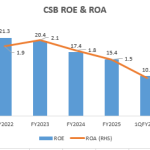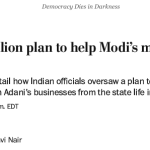Posted by Prabir Sorkel | August 14, 2025
Here is an excerpt from the report titled “Industrial Planning and Licensing Policy” of the Planning Commission published in 1967, authored by the legendary RK Hazari, one of the strongest advocates of bank nationalisation.
Among other things in this report he underlined how the credit disbursal of the banks need to be subjected to social and national priorities as determined by the planning process. At a time when market imperatives today are overriding people’s interest, the excerpt here shows how a collective say on credits ought to supersede the interests of a few Industrial houses. Today when corporate interests dominate the policy landscape, the excerpt here highlights the absolute necessity to snap the ties between private giants and banks and nationalise the banks.
The so called “reforms” have undone much of the directions of the likes of RK Hazari. But the massive corporate NPAs, mounting write offs, the dismantling of the priority sector, the credit crunch in the countryside, and the usurious NBFCs and MFIs preying on the poor today all point towards the need to take stock and roll back, to yet again pay heed to the likes of RK Hazari.
Excerpts:
“Credit planning is one of the main areas which has been left unexplored in the search for instruments to make planning more effective. Planned allocation of credit should, henceforth, assume the role of the principal strategic control for guidance of investment in both fixed assets and inventories, in place of the diffused variety of direct controls which have been in operation till recently. A number of measures would be required to make the flow of credit consistent with Plan priorities and the objective of reducing concentration of economic power. Some of these are indicated below.
A specified small but progressively increasing percentage of commercial bank deposits should be statutorily deposited with the Industrial Development Bank, at a rate of interest equivalent to the prevailing Bank Rate. Each percentage point of such deposits would, at present levels, fetch nearly Rs. 30 crores into IDB and thereby (a) reduce the draft on Government finances, and (b) make for more priority-based utilisation of public deposits with banks.
Second, a credit-deposit ratio should be laid down for commercial bank lending in the aggregate to priority sectors like agriculture, small industries, export, hire-purchase or sale on deferred payment of commercial vehicles and domestic machinery items. Within this ratio, individual banks should be free to decide the particular areas in which they are specially interested.
Third, for all individual short-term credit limits above Rs. 1 crore (whether with one or more banks), which account for a large proportion of total bank credit, constant check must be maintained not just on the security against the loan but the purpose for which the credit limit is utilised. Large borrowers should be required in principle to have a higher ratio of equity to debt and, also wherever possible, to have a shorter period of repayment…Financing of priority sector inventories should be considered almost as important as financing of fixed investment, even if this means denial of credit elsewhere.
These measures would change the traditional pattern of bank credit and, perhaps, reduce the availability of credit to a few sectors, which is unavoidable, given the total available volume of resources.
…At the risk of over-stepping my terms of reference, I should express my doubts about the viability of carrying through the above suggestions so long as many of the major credit institutions are under the direct control and/or influence of those who might suffer under the suggested arrangements. It would be difficult to undertake credit planning unless the linked control of industry and banks in the same nationalisation of banks.”














